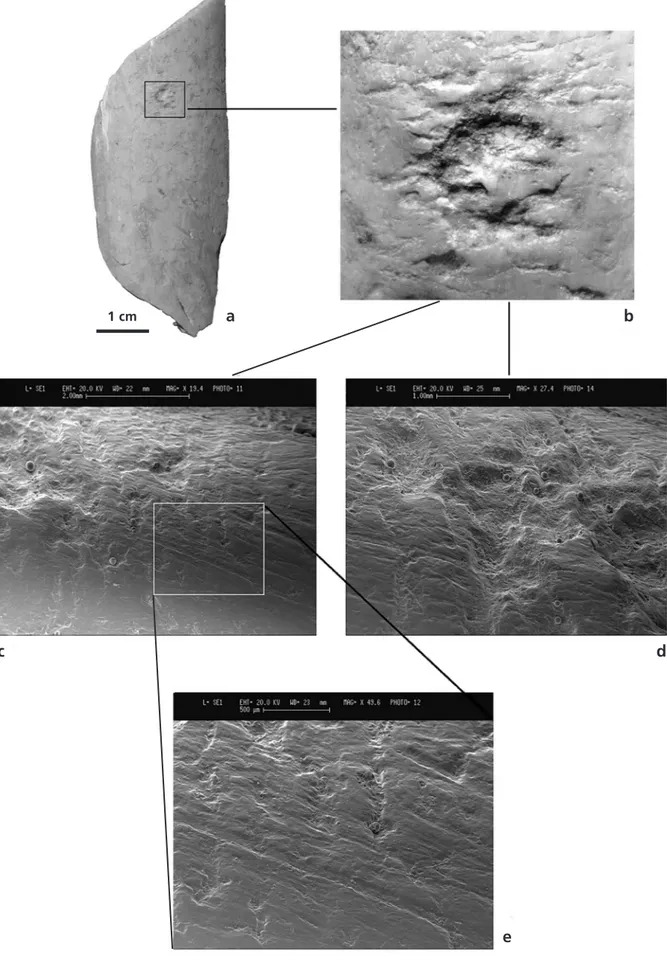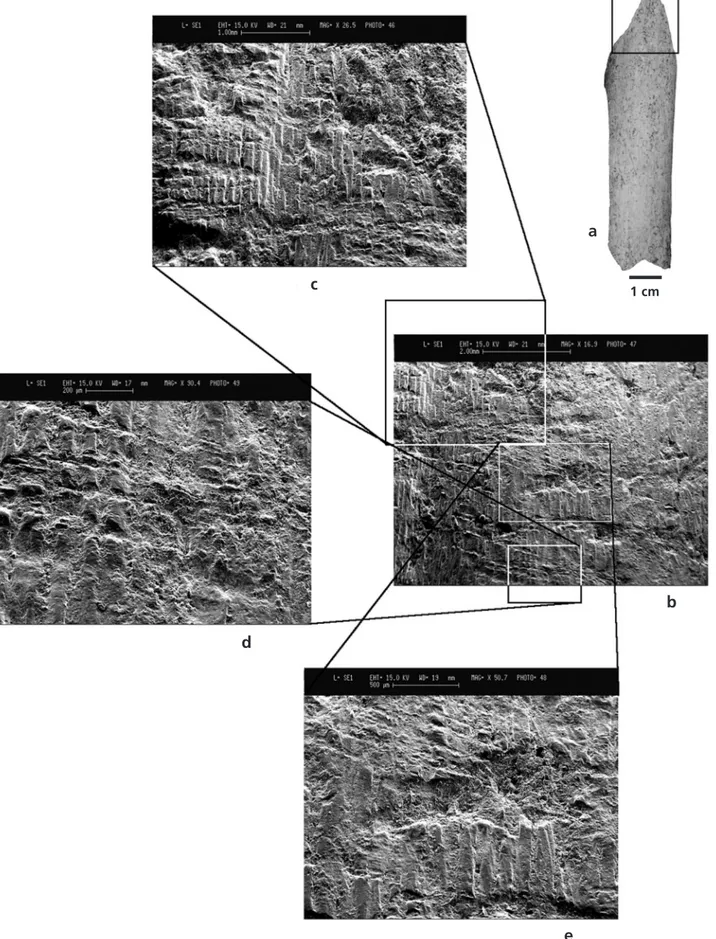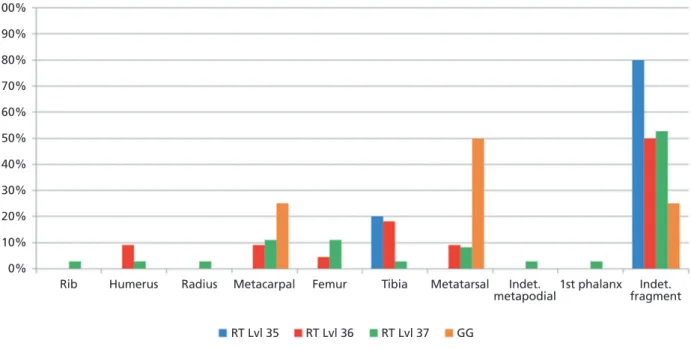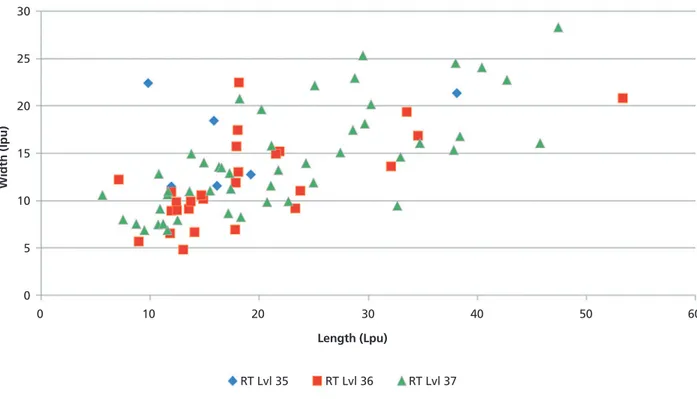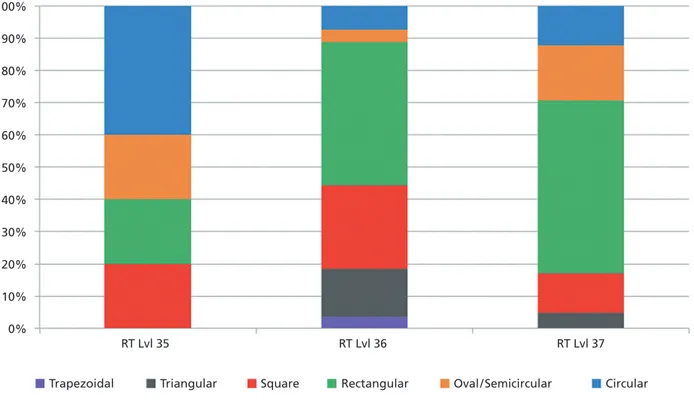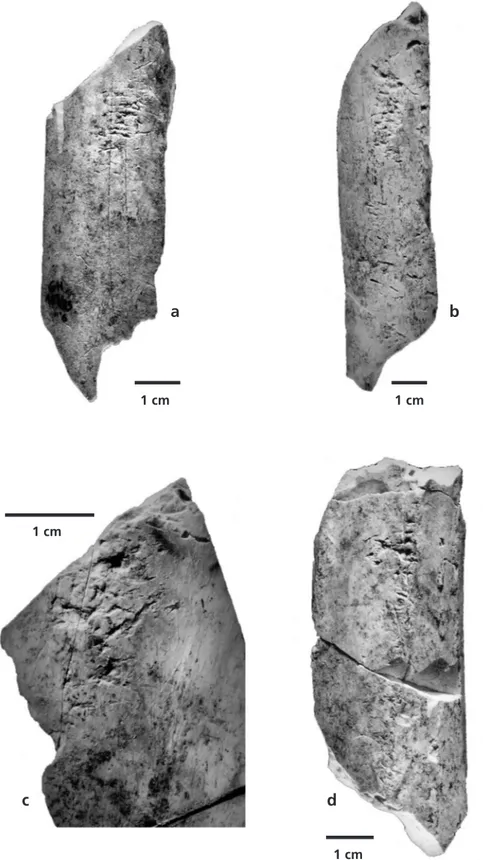URSULA THUN HOHENSTEIN · MARCO BERTOLINI · SHARADA CHANNARAYAPATNA ·
MARTA MODOLO · CARLO PERETTO
BONE RETOUCHERS FROM TWO NORTH ITALIAN MIDDLE
PALAEOLITHIC SITES: RIPARO TAGLIENTE AND GROTTA DELLA
GHIACCIAIA, VERONA
Abstract
The use of retouching tools made on hard animal materials has a broad chronological and geographical distribution throughout the European Palaeolithic. In Italy, analyses of retouchers are not particularly numer-ous. The current work presents the preliminary results obtained from the study of 79 retouchers recovered from two sites located in northern Italy: Riparo Tagliente and Grotta della Ghiacciaia, Verona. Results from Riparo Tagliente provide both qualitative and quantitative data, span several occupation levels, and the use traces on the cortical surfaces of these bone tools show great variability. Grotta della Ghiacciaia yields only qualitative data because of a restrictively small sample size. Overall, the retouchers analysed are mostly made on bone shafts of medium- to large-sized ungulates, especially red deer and other cervids, which were the most commonly hunted animals at the sites. Many examples were also made on the bones of small-sized mammals, such as roe deer. This variability can contribute to the identification of such tools at other sites and to better define a methodology for their analysis.
Keywords
Retouchers; Use areas; Middle Palaeolithic; Northern Italy
Introduction
One of the primary objectives of researchers in the field of prehistory is to understand the mechanisms involved in the behavioural evolution of ancient hominin groups. Even today, the degree of tech-nological and cultural development of prehistoric hunter-gatherer groups is assessed mainly through stone tools (Blasco et al., 2013). The contribution of other disciplines, zooarchaeology in particular, has brought added value to the acquisition of informa-tion related to hominin behaviour. The analysis of
faunal remains has not only aided the formulation of hypotheses regarding hominin prey spectra and the methods of animal carcass exploitation, but also the use of bones derived from butchery activities as raw materials.
The use of bone was not regularly included in the manufacture of stone tools until well into the Acheu-lean cultural complex, when various osseous mate-rials were used both as raw material to be shaped and as tools for shaping lithic implements (Blasco
et al., 2013). Retouchers on ungulate long bones were identified for the first time in the beginning of the 20th century (Daleau, 1884; Henri-Martin, 1906,
1907, 1907-1910) at the Middle Palaeolithic site of La Quina (Charente, France) and have since been recognized in numerous Middle Palaeolithic faunal assemblages from Europe.
Patou-Mathis and Schwab (2002) defined bone retouchers generically as fragments of large mam-mal remains, without modification of the original morphology, that present on their surfaces one or more impressed areas with various crushing marks, cupules and scores made by impact against a sharp edge of a stone flake, tool or handaxe. The absence of retouching tools in the archaeological record of many regions and chronological periods can be at-tributed to two principal factors: specific economic choices of the hunter-gatherers and the difficulty in recognizing these objects by archaeologists and fau-nal specialists.
In Italy, analyses of retouchers are not particularly numerous, beginning only in the second half of the 1990s with the recovery of such artefacts at Grotta di San Bernardino (Vicenza), Grotta di Fumane (Ve-rona) and Riparo Tagliente (Ve(Ve-rona) in northern Italy (Malerba and Giacobini, 1998). In a more recent study, 148 retouchers from the Mousterian and Ul-uzzian layers of Grotta di Fumane were analysed to assess the selection criteria of osseous blanks and their further patterns of retoucher use and discard by Middle Palaeolithic hominin populations in each of the stratigraphic units (Jéquier et al., 2012, 2013).
The current work presents the preliminary results obtained from the study of retouchers recovered from two other sites located in northern Italy: Ri-paro Tagliente and Grotta della Ghiacciaia, Verona. Our research is in progress, and this study represents the first step in the collection of basic descriptive data using current methodologies. This will provide a foundation for an interdisciplinary investigation devoted to a better understanding of Palaeolithic hominin behaviours in northern Italy related to bone retoucher use, including hunting strategies, bone blank selection, retouch typology and the relation-ship between the retouch type and bone blanks.
Background to the sites
Riparo Tagliente (Stallavena di Grezzana, Verona) is a key Mousterian site in northern Italy, located at the base of Monte Tregnago under a rockshelter formed by oolitic limestone. This strategic location features several karst cavities and an abundance of lithic and mineral resources, such as flint outcrops, which were heavily exploited by Palaeolithic groups, first by Neanderthals and later by anatomically modern humans. The rockshelter lies at 250 m a.s.l. on the eastern slope of Valpantena, one of the main val-ley bottoms of the pre-Alpine massif of the Lessini Mountains (Figure 1).
The discovery of the site is attributed to Fran-cesco Tagliente in 1958. Initial investigations were conducted from 1962 to 1964 by the Museo Civico di Storia Naturale of Verona. In 1967, excavations were started once again by the University of Fer-rara and are still ongoing. Cumulatively, these exca-vations have highlighted a long Upper Pleistocene stratigraphic series (over 4.5 m deep), comprising two main deposits separated by a fluvial erosion event: a lower deposit containing Mousterian (lev-els 52 to 31) and Aurignacian industries (level 25) and an upper deposit characterised by a Late Epigra-vettian materials (levels 18 to 4). Geological, bioar-chaeological and lithic typological data suggest that the lowermost series corresponds to an entire glacial cycle dating to between about 60,000 and 30,000 years ago (Bartolomei et al., 1982, 1984; Guerreschi et al., 2002; Fontana et al., 2009).
Lithic assemblage analyses testify that raw mate-rial supply came from slope waste deposits in the vicinity of the site and coarse gravels were procured from the streambed opposite the rockshelter. How-ever, from level 37 upwards, blade production was carried out using one specific kind of flint. Peresani (2009) observed that the Levallois method was still used even in the uppermost sequence, although uni- and bidirectional modalities were more fre-quent from level 37 upward. Centripetal reduction was featured in earlier levels. Discoid and unelabo-rated flaking methods may be attributed to spe-cific reduction sequences or to discard of exploited
0 50 100 150 km
Grotta della Ghiacciaia Riparo Tagliente
Venice Verona
Le vallois cores (Arzarello and Peretto, 2005). The upper levels (37-34) show a greater diversity of re-touched tools, likely a result of intense and long-term occupations of the site, as suggested by larger amounts of lithic and faunal remains relative to the lower levels.
Faunal analysis revealed an abundance of roe deer (Capreolus capreolus) and red deer (Cervus elaphus), followed by chamois (Rupicapra rupicapra) and ibex (Capra ibex), along with the presence of elk (Alces alces) and marmot (Marmota marmota) (Table 1). Palaeoenvironmentally, these species reflect a mod-erately humid, temperate-cold climate. A mixed bio-tope comprising forest, woodland areas and open steppe-grasslands marked the initial Mousterian phase. Increased aridity is indicted in levels 44-40, with a reduction in forest-dwelling species in favour of continental, Asian steppe fauna. In the upper part of the sequence, forest and woodland micro-mammals reappeared, but are less numerous than the open grassland or woody grassland forms (Fiore et al., 2004).
The frequency of anthropic modifications to un-gulate remains indicates that Neanderthals played an important role in the accumulation of the faunal assemblage (Thun Hohenstein et al., 2001; Alhaique et al., 2004). Evidence of carnivores at the site is sparse, possibly due to the long duration of hominin occupation.
Grotta della Ghiacciaia is located at 250 m a.s.l. on the left side of Progni Valley, near Grotta di Fu-mane in the western Lessini Mountains (see Figure 1). Preliminary investigations were carried out in 1979-80 under the direction of Carlo Peretto in col-laboration with the Museo Civico di Storia Naturale of Verona. The approximately 3.5 m thick deposit preserves an Upper Pleistocene series with three pedo-stratigraphic macro-units (Units 1, 2 and 3), which can be used to document palaeoenvironmen-tal changes at the site. At the base is the sterile Unit 1 associated with the Last Interglacial, succeeded by short-term anthropic levels of Units 2 and 3 asso-ciated with the First Pleniglacial (beginning of MIS 4). This chronology is derived from sedimentologi-Figure 1 Map of Italy showing the locations of Riparo Tagliente and Grotta della Ghiacciaia, Verona.
cal and palaeobotanical evidence (Peretto and Thun Hohenstein, 2002).
The lithic assemblages discovered in Units 2 and 3 are techno-typologically variable. While the Leval-lois method was exclusively employed in the later units, mainly by means of unidirectional modality, Quina and semi-Quina scrapers are present among the few artefacts found in the earlier units. More-over, throughout the series it is possible to recog-nise variation in the lithic assemblages, well evident in the frequency of retouched tools (Bertola et al., 1999).
Among the faunal remains (21 identified speci-mens), ibex (Capra ibex) is the most abundant spe-cies, followed by roe deer (Capreolus capreolus) and
bison (Bison priscus) (see Table 1). Red deer (Cervus elaphus) is conspicuously absent. The predominant species in both units are characteristic of high alti-tude grassland and cold steppe, although species typical of open forest environments are present in Unit 2. Changes in the small faunal composition suggest a gradual drying of the climate, from cold and humid to cold and arid.
No traces of carnivore activity were identified, al-though the remains of bear (Ursus sp.), wolf (Canis lupus) and fox (Vulpes vulpes) are present (Peresani et al., 2001). In contrast, Neanderthal butchery and intentional bone breakage are well documented. Some bones were also used as retouchers for stone tools (Bertola et al., 1999; Thun Hohenstein, 2001). Table 1 Number of identified specimens (NISP) and percentage contribution (%NISP) by taxa at Riparo Tagliente and Grotta della Ghiacciaia.
Taxa
Riparo Tagliente Grotta della Ghiacciaia
Level 35 Level 36 Level 37 Unit 2 Unit 3
NISP %NISP NISP %NISP NISP %NISP NISP %NISP NISP %NISP
Aves 3 2.6 6 2.2 2 1.1 - - - -Lepus sp. - - 1 0.4 1 0.5 - - - -Marmota marmota 4 3.5 15 5.4 24 12.8 - - - -Vulpes vulpes - - 3 1.1 - - 1 11.1 1 8.4 Canis lupus 3 2.6 2 0.7 1 0.5 1 11.1 3 25 Ursus sp. 2 1.8 2 0.7 - - 2 22.2 3 25 Carnivora 1 0.9 - - 4 2.2 - - - -Sus scrofa - - - - 2 1.1 - - - -Equus sp. 1 0.9 - - - -Rupicapra rupicapra 5 4.4 31 11.2 2 1.1 - - - -Capra ibex 4 3.5 17 6.2 14 7.5 4 44.5 1 8.3 Capreolus capreolus 79 69.3 137 49.6 108 58.1 - - 2 16.7 Cervus elaphus 8 7 38 13.8 14 7.5 - - - -Alces alces - - 4 1.4 2 1.1 - - - -Cervidae 4 3.5 2 0.7 5 2.7 - - - -Bison priscus - - - 1 11.1 1 8.3 Bos sp. - - - - 7 3.8 - - 1 8.3 Medium-sized ungulate - - 9 3.3 - - - -Large-sized ungulate - - 9 3.3 - - - -Total 114 100 276 100 186 100 9 100 12 100
Material and methods
The study material for the present research com-prises 79 bone retouchers sourced from Riparo Tagliente and Grotta della Ghiacciaia. Both sites are characterised by the occurrence of the same lithic technologies: volumetric Levallois and lami-nar débitage that is correlated by some authors with an important climatic fluctuation, which may have caused a change in Neanderthal techno-eco-nomic behaviour (Ameloot-Van Der Heijden, 1993; Tuffreau, 1993; Révillion, 1995; Arzarello and Pe-retto, 2005).
The total number of bone retouchers from the upper part of the Mousterian series of Riparo Tag-liente amounted to 75; however, 12 retouchers from this sample were not considered here, as their stratigraphical provenance was doubtful and their original morphology was not preserved. Therefore, only three levels (35, 36 and 37) with 63 bone re-touchers were taken into consideration for our study: five (8.0%) from level 35, 22 (34.9%) from level 36, and 36 (57.1%) came from layer 37. Only four retouchers from the anthropic levels of Grotta della Ghiacciaia were examined. Since the Riparo Tagliente sample has a higher number of bone re-touchers than at Grotta della Ghiacciaia, we ascribe to it greater significance. Accordingly, our prelimi-nary results will focus more on Riparo Tagliente.
The corpus of bone retouchers from the present study has been identified in previous zooarchaeo-logical analyses (Thun Hohenstein, 2001, 2006; Thun Hohenstein and Peretto, 2005). The methodo-logical approaches for formulating our analysis are based mainly on individual works published in the edited volume, Retouchoirs, compresseurs, percu-teurs…Os à impressions et éraillures (Patou-Mathis, 2002), particularly those by Giacobini and Patou-Mathis (2002) and Schwab (2002).
Our protocol commenced with taxonomic and anatomic identification of each bone retoucher. In a few cases, whenever precise taxonomic identifi-cation was not possible, the bone fragments were assigned to animal size class based on cortical thick-ness. In addition to identifying the skeletal element
from which the bone retoucher was derived, further attempts were made to determine the portion of the element and its laterality. The primary dimensions of the retouchers (maximum length, width and thick-ness) were measured in millimetres using a digital calliper. The weight of each retoucher was recorded in grams using an electronic scale.
The second step was to carry out a taphonomic analysis of the surfaces and edges of the retouchers to determine the state of preservation, type of frac-ture and degree of fragmentation. Bone fracfrac-tures were classified following Villa and Mahieu (1991). The taphonomic study was carried out using a Leica SD6 (6-40x) microscope. Fractures were either as-signed to anthropic or post-depositional factors, or a combination of both, and the bone tools were as-sessed to be complete, partially complete or frag-mented. Within these three categories, we docu-mented the shape and morphology of the bone blanks and the locations of the use areas.
For the sake of consistency in our analysis of the use areas, the retouchers were oriented by always placing the use area on the cortical surface in the apical (top) position on the bone blank (Mallye et al., 2012). In relation to the long axis (i.e., maximum length), the opposite end of the “apical” edge is designated as the “basal” edge. Similarly, the re-maining two sides lying on either side formed the “right” and “left” sides of the retoucher. When a retoucher preserved multiple use areas, the bone was reoriented to bring the use area to the apical position and the edges were re-designated.
To mark the exact location of the traces on the surface, we subdivided the surface of the tool into a grid, as proposed by Schwab (2002); rows were marked alphabetically and the columns numeri-cally. For measurement of the use areas and their distances from the margins of the retoucher, the approach advocated by Giacobini and Patou-Mathis (2002) was implemented. This entailed measuring the distance from the tip of the apical edge of the retoucher to the tip of the top portion of the use area (Dp-e), the maximum length (Lpu) and width (lpu) of the use area, and computing the area (Spu = Lpu*lpu) of the used portion on the retoucher.
With regards to codification of the morphology of the use areas, reference was made to the work of Mallye et al. (2012). The use area was assigned a nearest approximate shape: triangular, square, short or long rectangle, circular, semi-circular, ovoid or elliptical. Use areas were further categorised into the following three types based on superposition of traces: “hatched areas” characterized by the over-lapping of numerous scores on the surface; “pitted areas” with overlapping pits; and, “scaled areas” created by the superficial detachment of small bone plaques. The intensive use of a retoucher leads to overlapping traces.
The next procedure was the description of in-dividual traces within the use area. Nomenclature was again borrowed from Mallye et al. (2012). Pits are defined as triangular or ovoid depressions in the bone. Scores are shallow or deep incisions produced by the edge of a stone flake; score morphology can vary between rectilinear and sinuous, and the inte-rior surfaces of scores can be smooth or rough. In-dividual traces orientations were recorded using the codification scheme of Schwab (2002), with angles ranging from 0° to 180°.
Our protocol also included revised identifications of bone surface modifications present on the re-touchers, such as trampling marks and cut marks related to skinning and defleshing. The
alphabeti-cal and numerialphabeti-cal grid used for pinpointing the ex-act location of use areas (Schwab, 2002) was once more adopted to locate the other traces. The meth-ods adopted for orienting and describing the mor-phology of the other traces were the same as those adopted for use areas. For instance, linear surface modifications were described as oblique, longitu-dinal or transverse, while their arrangement with respect to each other was described as isolated, parallel, perpendicular, intersecting or chaotic. The retouchers were inspected for presence or absence of additional post-depositional traces such as weath-ering stages (Behrensmeyer, 1978), exfoliation, root etching, discolouration by oxides (manganese and iron), rounding, combustion and carnivore marks.
All retouchers were photographed at various magnifications. The traces were analysed and pho-tographed using a Leica SD6 stereomicroscope with an integrated EC3 camera. The more interesting tools were subsequently examined under SEM.
Results
Riparo Tagliente
Retouchers from Riparo Tagliente demonstrate well-preserved bone surfaces. Weathering (medium to Table 2 Taxonomic identification of the bone blanks used as retouchers at Riparo Tagliente
and Grotta della Ghiacciaia.
Taxa Riparo Tagliente Grotta della Ghiacciaia
Level 35 Level 36 Level 37 Unit 2 Unit 3
Rupicapra rupicapra - 1 - - -Capreolus capreolus - - 1 - -Cervus elaphus 2 3 2 1 1 Alces alces - 2 1 - -Bos sp. / Bison sp. - - 3 1 -Small-sized ungulate - 2 - - -Medium-sized ungulate - 12 17 - -Large-sized ungulate 3 2 12 1 -Total 5 22 36 3 1
Figure 2 Diaphyseal fragment of a large-sized ungulate utilised as a retoucher from Riparo Tagliente.
a b
c d
e
Figure 3 Retoucher on an indeterminate bone blank from Riparo Tagliente. a b c d e 1 cm
high degree) was one of the two chief alterations, observed on 44% of the retouchers. Weathering was associated with bones showing longitudinal fractures, which may have caused a general reduc-tion in blank width. The second primary alterareduc-tion was manganese oxide pigmentation, observed on 46% of retoucher surfaces. Exfoliation (5%) and root etching (5%) did not severely damage the bone surfaces.
The raw material for retouchers was obtained from red deer long bone diaphyses, followed in abundance by aurochs/bison and elk from layer 35 and 37 of Riparo Tagliente (Figure 2). Retouchers on chamois bones were present only in level 36. The use of small-sized animals such as roe deer and chamois was noticed in level 36 and 37 (Table 2).
In terms of anatomical part representation, long bones with flat surfaces, such as metapodial, tibia and numerous indeterminate limb shaft fragments (Figure 3), were preferred; less frequent were hu-merus, radius and femur (Figure 4). In level 37, two interesting exceptions were the exploitation of a first phalanx of roe deer (Figure 5) and rib of a large ungulate.
Analysis of diaphyseal fragments showed that com plete and partially complete retouchers account-ed for approximately 70-80% of the total, whereas the remaining 20-30% were fragmented and only preserved a fraction of their original morphology.
Roughly 70% of the bone retouchers have only one use area when all three levels are taken into consideration. Two use areas were documented on around 20% of retouchers, and only two examples from level 37 have three use areas. There is no as-sociation between the number of use areas and the length of the bone blanks. In fact, there are retouch-ers longer than 100 mm with just one use area. Many retouchers with two use areas are at least 50 mm long, but shorter than some retouchers with only one use area.
The ratio of length to width of the use area is ho-mogenous in all the three levels of Riparo Tagliente. There is a clear increase in use area dimensions in levels 36 and 37 (Figure 6), which could be related to the débitage method utilized. This will be investi-gated in future studies.
There does seem to be a positive association be-tween the use area dimensions and the length of
Figure 4 Percentage contribution of anatomical elements as raw material sources at Riparo Tagliente (RT) and Grotta della Ghiacciaia (GG). 100% 90% 80% 70% 60% 50% 40% 30% 20% 10% 0%
Rib Humerus Radius Metacarpal Femur Tibia Metatarsal Indet.
metapodial1st phalanx fragmentIndet.
the tool. This was observed mainly in level 37, due to the presence of long and intensively used retouchers from limb shafts of large-sized ungulate shafts, such as aurochs/bison and elk (Figure 7).
The Riparo Tagliente sample revealed diversity in use area shape. Morphologically, the most preva-lent shape was rectangular, accounting for 44% and 54% in levels 36 and 37, respectively (Figure 8). In level 35, 40% of the use areas were circular; square, rectangular and oval / semicircular contri -bu t ed equally with 20% each. Trapezoidal use areas were recorded only in level 36 and accounted for only 4% of the use area shapes on retouchers in that level. Triangular use areas were absent in level 35, but made up roughly 15% of the total use areas in level 36 and 5% in level 37.
Linear scores associated with cupules were com-mon, occurring together in 71% of retouchers in level 36 and in 61% in level 37. In level 35, 75% of the traces were linear scores with cupules, while the remaining 25% was a combination of linear scores, cupules and pits (Figure 9). This relationship may be explained by an intensive exploitation of the tools. Cases in which the traces were isolated or diffuse are rare.
Among retouchers, there were variations in the depths of the traces that could be associated with
the state of the blanks, whether fresh or of interme-diate freshness. Although it is difficult to quantify, Mallye et al. (2012) suggest that some traces are shallower on fresh bone than on bones of intermedi-ate freshness. The traces observed on the retouchers from Riparo Tagliente were fairly deep, suggesting a preference for bones with an intermediary freshness for use as retouchers.
Linear scores were mostly oriented transversely (0°-30° and 150°-180°) with respect to the main axis of the tool, which indicates that there was a standard positioning of the bone retoucher with respect to the flint edge. This observation was bet-ter represented in retouchers from levels 35 and 37. Scores oriented parallel or sub-parallel (60°-90° and 90°-120°) to the main longitudinal axis of the tool were rare in all three levels (Figure 10).
To sum up, with respect to the characteristics of the use areas, the favoured blanks for retouchers at Riparo Tagliente were diaphysis fragments from medium- to large-sized ungulates of intermediate freshness.
Grotta della Ghiacciaia
The raw material for retouchers at Grotta della Ghi-acciaia is similar to Riparo Tagliente: red deer and Figure 5 Retoucher on a roe deer (Capreolus capreolus) first phalanx from Riparo Tagliente.
a b
Figure 6 Ratio of length (Lpu) to width (lpu) of the use areas in the three levels at Riparo Tagliente (RT). Lpu and lpu are measured in mm.
Figure 7 Ratio of the use areas dimensions (Spu) to length of the tool in the three levels at Riparo Tagliente (RT). Spu is measured in mm2; length is measure in mm.
30 25 20 15 10 5 0 Length (Lpu) RT Lvl 35 RT Lvl 36 RT Lvl 37 Width (Ipu) 0 10 20 30 40 50 60 1600 1400 1200 1000 800 600 400 200 0 Length (Lpu) RT Lvl 35 RT Lvl 36 RT Lvl 37 USe ar ea dimension (Spu) 0 20 40 60 80 100 120 140 160
Figure 8 Percentage distribution of use area shapes on retouchers from Riparo Tagliente (RT). Total number of use areas = 74.
Figure 9 Percentage distribution of use trace types on retouchers from Riparo Tagliente (RT). Total number of use areas = 74. 100% 90% 80% 70% 60% 50% 40% 30% 20% 10% 0% RT Lvl 35 RT Lvl 36 RT Lvl 37
Trapezoidal Triangular Square Rectangular Oval/Semicircular Circular
100% 90% 80% 70% 60% 50% 40% 30% 20% 10% 0% RT Lvl 35 RT Lvl 36 RT Lvl 37
aurochs / bison long bone diaphyses (Table 2). Two of the four retouchers were identified as red deer metapodia, the third is a metatarsal diaphysis of au-r ochs / bison, and the fouau-rth is an unidentified di-aphysis of large ungulate, likely aurochs or bison (see Figure 4; Figure 11).
All four retouchers were stained by manganese and iron oxides. The initial stages of weathering were seen on three of the four retouchers. The cortical surfaces on all four retouchers showed post-depo-sitional trampling marks. These marks were mostly oriented obliquely to the main longitudinal axis of the bone and only a few were oriented transversely.
Out of the four retouchers, three had only one use area and the other had three use areas. Among the six total use areas, rectangular shapes were documented in two retouchers. Triangular, square, oval and circular use area shapes occurred only once each. Linear traces and cupules were observed to-gether in two retouchers and separately in the other two retouchers. In three out of four retouchers, a majority of the linear traces were oriented
trans-versely (0°-30° and 150°-180°) to the main longi-tudinal axis of the tool. On the contrary, cupules on one retoucher were found to be oriented parallel to the main longitudinal axis. Obliquely oriented traces were less common overall.
Conclusions
The analysis of retouchers from Grotta della Ghiac-ciaia provided only qualitative information where as Riparo Tagliente yielded both qualitative and quan-titative data. The heavily fragmented bone retouch-ers from Grotta della Ghiacciaia were found to be impacted by post-depositional processes. Bone blanks of intermediate freshness from large ungu-lates seem to have been the preferred raw material for utilisation as retouchers. Riparo Tagliente is the more significant sample analysed here. Blanks of in-termediate freshness were most frequently utilised and the best-preserved specimens were also from large ungulates.
Figure 10 Percentage distribution of use trace orientations on retouchers from Riparo Tagliente (RT). Total number of use areas = 74. 100% 90% 80% 70% 60% 50% 40% 30% 20% 10% 0% RT Lvl 35 RT Lvl 36 RT Lvl 37 0o-30o 30o-60o 60o-90o 90o-100o 120o-150o 150o-180o
Figure 11 Retouchers on metapodial blanks (A, B), a large-sized ungulate diaphysis (C) and a tibia shaft (D) from Grotta della Ghiacciaia.
a 1 cm b 1 cm c d 1 cm 1 cm
This was a preliminary study of retouchers from Riparo Tagliente and Grotta della Ghiacciaia. Future studies will address the completeness and original shape of the bone blanks, correlations between scraping marks and the use areas and the descrip-tion of other traces and use areas in order to deter-mine their relationship to knapping and/or butchery activities. These further studies, paired with an ex-perimental programme, will clarify the association between bone retouchers and débitage methods at these sites and will aid in increasing our
understand-ing of the use of bone retouchers in northern Italy during the Upper Pleistocene.
Acknowledgments
The authors wish to thank two anonymous ref -erees and are very grateful to Jarod Hutson for his comments and editing. Research was carried out within funding FAR2013, Università degli Studi di Ferrara.
References
Alhaique, F., Bisconti, M., Castiglioni, E., Cilli, C., Fasani, L., Giaco-bini, G., Grifoni, R., Guerreschi, A., Iacopini A., Malerba, G., Per-etto, C., Recchi, A., Rocci Ris, A., Ronchitelli, A., Rottoli, M., Thun Hohenstein, U., Tozzi, C., Visentini, P., Wilkens, B., 2004. Animal resources and subsistence strategies. Coll. Antropol. 28, 23-40. Ameloot-Van Der Heijden, N., 1993. L’industrie laminaire du niveau
C.A. du gisement paléolithique moyen de Riencourt-lès-Bap-aume (Pas-de-Calais). Bull. Soc. Préhist. Fr. 90, 324-327. Arzarello, M., Peretto, C., 2005. Nouvelles données sur les
caracté-ristiques et l’évolution techno-économique de l’industrie mousté-rienne de Riparo Tagliente (Verona, Italie). In: Molines, N., Moncel, M.-H., Monnier, J.L. (Eds.), Les premiers peuplements en Europe: Colloque International: Données récentes sur les modalités de peuplement et sur le cadre chronostratigraphique, géologique et paléogéographique des industries du Paléolithique ancien et moyen en Europe. Rennes, 22-25 Septembre 2002. BAR Interna-tional Series 1364. Archaeopress, Oxford, pp. 281-289.
Bartolomei, G., Broglio, A., Cattani, L., Cremaschi, M., Guerreschi, A., Mantovani, E., Peretto, C., Sala, B., 1982. I depositi würmiani del Riparo Tagliente. Ann. Univ. Ferrara (N.S.) 15, 61-105. Bartolomei, G., Broglio, A., Cattani, L., Cremaschi, M., Guerreschi,
A., Leonardi, P., Peretto, C., 1984. I giacimenti paleolitici e meso-litici. In: Aspes, A. (Ed.), Il Veneto nell’Antichità: Preistoria e Pro-tostoria. Banca Popolare di Verona, Verona, pp. 169-319. Behrensmeyer, A.K., 1978. Taphonomic and ecologic information
from bone weathering. Paleobiology 4, 150-162.
Bertola, S., Peresani, M., Peretto, C., Thun Hohenstein, U., 1999. Le site paléolithique moyen de la Grotte della Ghiacciaia (Préalpes de Vénétie, Italie du Nord). L’Anthropologie 103, 377-390. Blasco, R., Rosell, J., Cuartero, F., Fernández Peris, J., Gopher, A.,
Bar-kai, R., 2013. Using bones to shape stones: MIS 9 bone retouchers at both edges of the Mediterranean Sea. PLOS ONE 8, e76780. Daleau, F., 1884. Sur des lésions que présentent certains os de la
pé-riode paléolithique. In: Association Française pour l'Avancement des Sciences, Compte Rendu de la 12e Session, Rouen 1883.
Chaix, Paris, pp. 600-602.
Fiore, I., Gala, M., Tagliacozzo, A., 2004. Ecology and subsistence strategies in the eastern Italian Alps during the Middle Palaeo-lithic. Int. J. Osteoarchaeol. 14, 273-286.
Fontana, F., Cilli, C., Cremona, M.G., Giacobini, G., Gurioli, F., Liagre, J., Malerba, G., Rocci Ris, A., Veronese, C., Guerreschi, A., 2009. Recent data on the Late Epigravettian occupation at Riparo Tagliente, Monti Lessini (Grezzana, Verona): a multidisci-plinary perspective. Preist. Alpina 44, 51-59.
Giacobini, G., Patou-Mathis, M., 2002. Fiche rappels taphonom-iques. In: Patou-Mathis, M. (Ed.), Retouchoirs, Compresseurs, Percuteurs...Os à Impressions et à Éraillures. Fiches Typologiques de l’Industrie Osseuse Préhistorique, Cahier X. Éditions Société Préhistorique Française, Paris, pp. 21-28.
Guerreschi, A., Peretto, C., Thun Hohenstein, U., 2002. I depositi di Riparo Tagliente. In: Aspes, A. (Ed.), Preistoria Veronese: Con-tributi e Aggiornamenti. Memorie del Museo Civico di Storia Naturale, II Serie, Sezione Scienze dell'Uomo 5. Museo Civico di Storia Natural, Verona, pp. 15-18.
Henri-Martin, L., 1906. Maillets ou enclumes en os provenant de la couche moustérienne de la Quina (Charente). Bull. Soc. Préhist. Fr. 3, 155-162.
Henri-Martin, L., 1907. Présentation d’ossements utilisés de l’époque moustérienne. Bull. Soc. Préhist. Fr. 4, 269-277.
Henri-Martin, L., 1907-1910. Recherches sur l'Évolution du Mous-térien dans le Gisement de la Quina (Charente): Industrie Os-seuse. Schleicher Frères, Paris.
Jéquier, C., Romandini, M., Peresani, M., 2012. Les retouchoirs en matières dures animales: une comparaison entre Moustérien fi-nal et Uluzzien. C. R. Palevol. 11, 283-292.
Jéquier, C., Romandini, M., Peresani, M., 2013. Osseous retouchers from the final Mousterian and Uluzzian levels at Fumane Cave (Verona, Italy): preliminary results. In: Choyke, A.M., O’Connor, S. (Eds.), From these Bare Bones: Raw Materials and the Study of Worked Osseous Objects. Proceedings of the Raw Materials Session at the 11th ICAZ Conference, Paris, 2010. Oxbow Books,
Malerba, G., Giacobini, G., 1998. Les restes fauniques du Paléo-lithique moyen de la Grotte de San Bernardino (Vicenza, Italie nord-orientale): analyse micromorphologique des surfaces osseuses. In: Facchini, F., Palma di Cesnola, A., Piperno, M., Peretto, C. (Eds.), Proceedings of the XIII International Congress of the Union of Prehistoric and Protohistoric Sciences (Forlì, Italia, 8-14 September 1996), Volume 6. ABACO Edizioni, Forlì, pp. 203-208.
Mallye, J.B., Thiébaut, C., Mourre, V., Costamagno, S., Claud, É., Weisbecker, P., 2012. The Mousterian bone retouchers of Noise-tier Cave: experimentation and identification of marks. J. Ar-chaeol. Sci. 39, 1131-1142.
Patou-Mathis, M. (Ed.), 2002. Retouchoirs, Compresseurs, Per-cuteurs…Os à Impressions et à Éraillures. Fiches Typologiques de l’Industrie Osseuse Préhistorique, Cahier X. Éditions Société Préhistorique Française, Paris.
Mathis, M., Schwab, C., 2002. Fiche générale. In: Patou-Mathis, M. (Ed.), Retouchoirs, Compresseurs, Percuteurs...Os à Impressions et à Éraillures. Fiches Typologiques de l’Industrie Osseuse Préhistorique, Cahier X. Éditions Société Préhistorique Française, Paris, pp. 11-19.
Peresani, M., Bertola, S., Peretto, C., Thun Hohenstein U., 2001. Paleoecological and paleoeconomic aspects of the Middle Palae-olithic site of the Ghiacciaia Cave (Venetian PreAlps). In: Spedini, G., Destro-Bisol, G., Manzi, G. (Eds.), Attualità dell'Antropologia: Ricerca e Insegnamento nel XXI Secolo. Atti del XIII Congresso degli Antropologi Italiani, Roma-Sabaudia, 4-8 Ottobre 1999. Associazione Antropologica Italiana, Università di Roma La Sa-pienza, Rome, pp. 3-7.
Peresani, M., 2009. Notes on the Neanderthal behaviour during the isotopic stage 3 in the alpine fringe of Italy. Gortania. Geologia, Paleontologia, Paletnologia 31, 87-96.
Peretto, C., Thun Hohenstein, U., 2002. Riparo Tagliente. In: Aspes, A. (Ed.), Preistoria Veronese: Contributi e Aggiornamenti. Memo-rie del Museo Civico di Storia Naturale, II SeMemo-rie, Sezione Scienze dell'Uomo 5. Museo Civico di Storia Natural, Verona, pp. 24-25. Révillion, S., 1995. Technologie du débitage laminaire au Paléoli-thique moyen en Europe sèptentrionale: état de la question. Bull. Soc. Préhist. Fr. 92, 425-441.
Schwab, C., 2002. Fiche éclats diaphysaires du Paléolithique moyen et supérieur: la grotte d’Isturitz (Pyrénées-Atlantique). In: Patou-Mathis, M. (Ed.), Retouchoirs, Compresseurs, Percuteurs...Os à Impressions et à Éraillures. Fiches Typologiques de l’Industrie Osseuse Préhistorique, Cahier X. Éditions Société Préhistorique Française, Paris, pp. 59-73.
Thun Hohenstein, U., 2001. Strategie di sussistenza e comporta-mento dell’uomo di Neandertal. Analisi archeozoologica dei li velli musteriani del Riparo Tagliente, Grotta della Ghiacciaia (Italia) e Abric Romani (Spagna). Ph.D. Dissertation, Consorzio Universitario di Bologna, Ferrara e Parma.
Thun Hohenstein, U., 2006. Strategie di sussistenza adottate dai Neandertaliani nel sito di Riparo Tagliente (Prealpi venete). In: Sala, B., Tecchiati, U. (Eds.), Studi di Archeozoologia in Onore del Prof. Alfredo Riedel. Ripartizione Beni Culturali, Ufficio Beni Ar-cheologici, Provincia autonoma di Bolzano-Alto Adige, Bolzano, pp. 31-38.
Thun Hohenstein, U., Malerba, G., Giacobini, G., Peretto, C., 2001. New contribution to the taphonomic analysis of the faunal re-mains from the Mousterian levels of Riparo Tagliente (Verona). In: Spedini, G., Destro-Bisol, G., Manzi, G. (Eds.), Attualità dell' Antropologia: Ricerca e Insegnamento nel XXI Secolo. Atti del XIII Congresso degli Antropologi Italiani, Roma-Sabaudia, 4-8 Ottobre 1999. Associazione Antropologica Italiana, Università di Roma La Sapienza, Rome, pp. 39-44.
Thun Hohenstein, U., Peretto, C., 2005. The exploitation of the fau-nal remains in the Mousterian levels at Riparo Tagliente (Verona, Italy). In: Molines, N., Moncel, M.-H., Monnier, J.L. (Eds.), Les Premiers Peuplements en Europe. Colloque International: Don-nées Récentes sur les Modalités de Peuplement et sur le Cadre Chronostratigraphique, Géologique et Paléogéographique des Industries du Paléolithique Ancien et Moyen en Europe, Rennes, 22-25 Septembre 2002. BAR International Series 1364. Archaeo-press, Oxford, pp. 261-268.
Tuffreau, A., 1993. Riencourt-lès-Bapaume (Pas-de-Calais): un Gise-ment du Paléolithique Moyen. DocuGise-ments d'Archéologie Fran-çaise 37. Éditions de la Maison des Sciences de l'Homme, Paris. Villa, P., Mahieu, E., 1991. Breakage patterns of human long bones.
J. Hum. Evol. 21, 27-48.
Ursula Thun Hohenstein a,*, Marco Bertolini a, Sharada Channarayapatna a, Marta Modolo b, Carlo Peretto a
a Department of Humanities, University of Ferrara, Laboratory of Archaeozoology and Taphonomy, Corso Ercole I d’Este 32, 44121, Ferrara, Italy
b IPHES, Institut Català de Paleoecologia Humana i Evolució Social, Universitat Rovira i Virgili, Campus Catalunya, 43007 Tarragona, Spain
